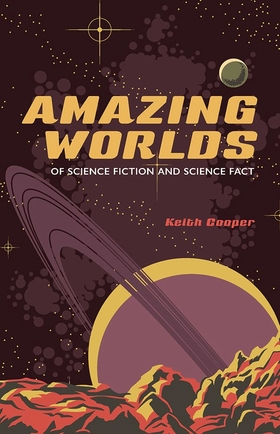Centauri Dreams
Imagining and Planning Interstellar Exploration
An Interstellar Visitor?
An object called A/2017 U1, whether it is an asteroid or a comet, is drawing attention because it seems to be an interstellar wanderer. Discovered on October 19 by the University of Hawaii’s Pan-STARRS 1 telescope on Haleakala, the object was quickly submitted to the Minor Planet Center by Rob Weryk (University of Hawaii Institute for Astronomy, IFA). Weryk was subsequently able to identify the object in Pan-STARRS imagery from the previous night.
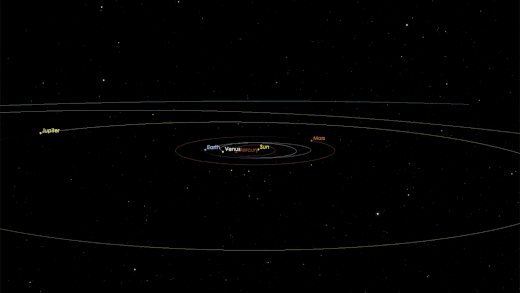
Image: This animation shows the path of A/2017 U1, which is an asteroid — or perhaps a comet — as it passed through our inner solar system in September and October 2017. From analysis of its motion, scientists calculate that it probably originated from outside our Solar System. Credit: NASA/JPL-Caltech.
Thus a nightly search for near-Earth objects may have uncovered an object whose origins lie much further away. A/2017 U1 is about 400 meters in diameter and on a highly unusual trajectory, one that fits neither an asteroid or comet from our own Solar System. Davide Farnocchia (JPL) is a scientist at NASA’s Center for Near-Earth Object Studies (CNEOS):
“This is the most extreme orbit I have ever seen,” said Farnocchia. “It is going extremely fast and on such a trajectory that we can say with confidence that this object is on its way out of the Solar System and not coming back.”
Thus we seem to be looking at an object unattached to any star. That such objects exist is hardly a surprise, as we already know there is a robust population of planets that have been ejected from their own stellar systems and wander alone through interstellar space. But if confirmed as such a wandering object, A/2017 U1 would be the first ever observed coming through our own Solar System.
“We have long suspected that these objects should exist, because during the process of planet formation a lot of material should be ejected from planetary systems. What’s most surprising is that we’ve never seen interstellar objects pass through before,” said Karen Meech, an astronomer at the IfA specializing in small bodies and their connection to Solar System formation.
Coming from the direction of the constellation Lyra and moving at 25.5 kilometers per second, A/2017 U1 evidently entered our Solar System from above the ecliptic, crossing the ecliptic plane inside the orbit of Mercury and reaching perihelion on September 9. As the illustration above makes clear, its trajectory was deflected by the Sun’s gravity and it passed ‘under’ the Earth’s orbit on October 14 at a distance of some 24 million kilometers. It is now back above the plane of the planets, moving at 44 kilometers per second, heading toward Pegasus.
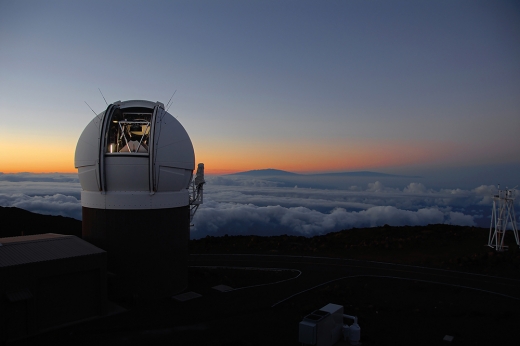
Image: The Pan-STARRS1 Observatory on Halealakala, Maui, opens at sunset to begin a night of mapping the sky. Credit: Photo by Rob Ratkowski.
We’ll have to see what naming conventions come into play if this object is indeed confirmed as an interstellar traveler, putting the onus on the International Astronomical Union to come up with something interesting. You may remember that asteroid 31/439 wound up getting named ‘Rama’ in Arthur C. Clarke’s fine tale Rendezvous with Rama (1973), though we’re unlikely to find that A/2017 U1 is as intriguing as Clarke’s mysterious starship bound for the Magellanics.
Meanwhile, we’re reminded of yet another reason why wide-field surveys of the sky make sense. While we engage in the great task of planetary protection, we also make discoveries like this one, following up with the kind of detailed observations now underway. Compiling the necessary data will help us pin down the origin of this intriguing visitor.

Planet Formation in Cometary Rings
Just how do you go about building a ‘super-Earth’? One possibility may be emerging in the study of young debris disk systems with thin, bright outer rings made up of comet-like bodies. Three examples are under scrutiny in work discussed at the recent American Astronomical Society’s Division for Planetary Sciences meeting in Provo, Utah. Here, Carey Lisse (JHU/APL) described his team’s results in studying the stars Fomalhaut, HD 32297 and HR 4796A.
What the scientists are finding is that dense rings of comets can become a construction zone for planets of super-Earth size. The makeup of the material in these ring systems varies, from two that are rich in ice (Fomalhaut and HD 32297) to one that is depleted in ice but rich in carbon (HR 4796A). Take a look at the image below, showing the ring surrounding HR 4796A, and you’ll see how strikingly tight the band of dust around this relatively young stellar system is.
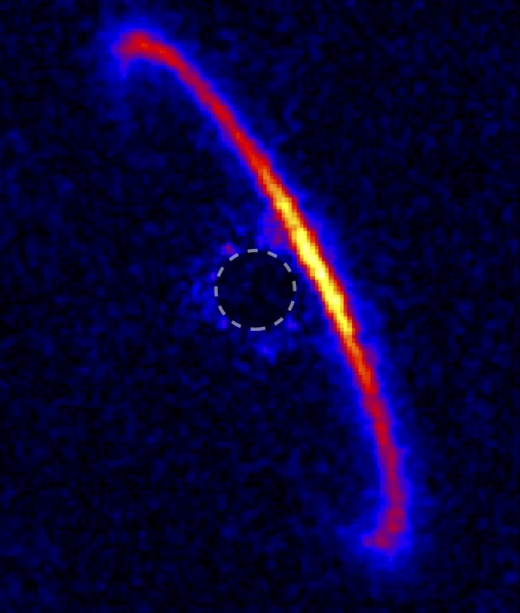
Image: Gemini Planet Imager observations reveal a complex pattern of variations in brightness and polarization around the HR 4796A disk. Credit: Marshall Perrin (Space Telescope Science Institute), Gaspard Duchene (UC Berkeley), Max Millar-Blanchaer (University of Toronto), and the GPI Team.
What causes the dust ring here? Lisse believes its red color is the result of the burnt-out rocky remains of comets, with the ring system close enough to the central star that the original materials have largely boiled off. At Fomalhaut and HD 32297, cometary dust containing ices is found, the ring systems being far enough from the central star that their comets remain cold and stable.
But the tight structure of these three ring systems is still problematic, because in young systems we would expect to see a much less orderly situation as the early era of planet formation proceeds. We also see little circumstellar gas in these systems.
Here we might think of what Cassini showed us at Saturn in the form of small ‘shepherding’ moons that preserve ring structure. Could something similar be happening around these stars, varying according to temperature, as emerging planets begin to take shape? Lisse believes this to be the case:
“Comets crashing down onto these growing planet surfaces would kick up huge clouds of fast-moving, ejected ‘construction dust,’ which would spread over the system in huge clouds. The only apparent solution to these issues is that multiple mini-planets are coalescing in these rings, and these small bodies, with low kick-up velocities, are shepherding the rings into narrow structures — much in the same way many of the narrow rings of Saturn are focused and sharpened.”

Image: ALMA image of the debris disk in the Fomalhaut star system. The ring is approximately 20 billion kilometers from the central star and about 2 billion kilometers wide. The central dot is the unresolved emission from the star, which is about twice the mass of our Sun. Credit: ALMA (ESO/NAOJ/NRAO); M. MacGregor.
This is an interesting model because it distributes planet formation into a series of small processes within the ring structure. Lisse and team believe that in Fomalhaut and HD 32297, they are seeing the formation of planets out of materials supplied by millions of comets, with planetary cores emerging similar to those of the ice giants Uranus and Neptune. But in this case, the gas disks that would contribute to atmospheres are gone. In HR 4796A, with a warmer dust ring, the core building materials are reduced to leftover carbon and rocky debris.
From a recent Lisse et al. paper on this star:
Our results are consistent with an HR 4796A system consisting of a narrow sheparded belt of devolatilized cometary material associated with multiple rocky subcores forming a planet, and a small steady stream of dust inflowing from this belt to a rock sublimation zone at ~1 AU from the primary. These subcores were built from comets that have been actively emitting large, reddish dust for > 0.4 Myr at ~100K (the temperature at which cometary activity onset is seen in our Solar System).
The potential result: The kind of ‘super-Earth’ planets we do not see in our own Solar System (unless we find such in the conjectured ‘Planet Nine’). The Kepler results showed us super-Earths in abundance. Now this cometary ring theory gives us a way to account for their formation. Still to be resolved: The amount of time it is taking for these planets to finish their formation, a period that has been long enough to see the primordial gas in the stellar disks stripped away. Even Lisse concludes that the issue remains ‘a big mystery.’
The paper on HR 4796A is Lisse et al., “Infrared Spectroscopy of HR 4796A’s Bright Outer Cometary Ring + Tenuous Inner Hot Dust Cloud,” accepted at the Astronomical Journal (preprint).

Probing General Relativity with Neutron Stars
Another of those ‘new eras’ I talked about in yesterday’s post is involved in the latest news on gravitational waves. Let’s not forget that it was 50 years ago — on November 28, 1967 — that Jocelyn Bell Burnell and Antony Hewish observed the first pulsar, now known to be a neutron star. It made the news at the time because the pulses, separated by 1.33 seconds, raised a SETI possibility, leading to the playful designation LGM-1 (‘little green men’) for the discovery.
We’ve learned a lot about pulsars emitting beams at various wavelengths since then and the SETI connection is gone, but before I leave the past, it’s also worth recognizing that our old friend Fritz Zwicky, working with Walter Baade, first proposed the existence of neutron stars in 1934. The scientists believed that a dense star made of neutrons could result from a supernova explosion, and here we might think of the Crab pulsar at the center of the Crab Nebula, an object whose description fits the pioneering work of Zwicky and Baade, and also tracks the work of Franco Pacini, who posited that a rotating neutron star in a magnetic field would emit radiation. Likewise a pioneer, Pacini suggested this before pulsars had been discovered.

Writing about all this takes me back to reading Larry Niven’s story ‘Neutron Star,’ available in the collection by the same name, when it first ran in a 1966 issue of IF. Those were interesting days for IF, but I better cut that further digression off at the source — more about the magazine in a future post. ‘Neutron Star’ is the story where Beowulf Shaeffer, a familiar character in Larry’s Known Space stories, first appears. If you want to see a neutron star up close and learn what its tidal forces can do, you can’t beat Niven’s tale.
Typically, a neutron star will get up to two solar masses while showing a diameter of a mere 20 kilometers, telling us it’s made of a kind of dense matter about which we have much to learn. Scientists at the Max Planck Institutes for Gravitational Physics and for Radio Astronomy have been looking at two major tools for studying the intense gravity associated with neutron stars: Pulsar timing and gravitational wave observations like the recent GW170817 event.
What’s interesting here is that neutron stars can help us investigate theories of gravity in which the gravitational fields associated with their interactions may differ from what General Relativity predicts. Lijing Shao, lead author of the paper coming out of this work, notes that alternate theories of gravity will produce different predictions on the behavior of binary neutron star systems. The paper gives us a glimpse of the kind of analyses gravitational wave astronomy will enable.
“The gravitational acceleration at a neutron star’s surface is about 2×1011 times that of the Earth which makes them excellent objects to study Einstein’s general relativity and alternative theories in the strong-field regime. In a systematic investigation with pulsar timing technologies, we were able to put constraints on a class of alternative gravity theories showing for the first time in detail how they depend on the physics of the extremely dense matter they contain.”
All this emerges as the “equation of state” of neutron stars. Equations of state relate pressure, volume and temperature in a particular substance that is in thermodynamic equilibrium. Shao and colleagues have been studying possible equations of state for five binary pulsar systems, each of which contains a neutron star and a white dwarf. They believe that gravitational wave detectors will soon become sensitive enough to investigate alternate gravitational theories.
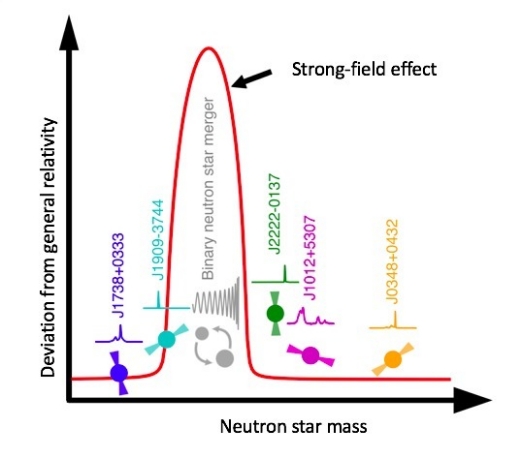
Image: The constraints on deviations from general relativity set by pulsar timing leave a gap between about 1.6 – 1.7 solar masses. Gravitational wave observations of binary neutron stars of the appropriate mass could fill this gap and thus further constrain alternative theories of gravity. Credit and Copyright: L. Shao (Max Planck Institute for Gravitational Physics & Max Planck Institute for Radio Astronomy), N. Sennett, A. Buonanno (Max Planck Institute for Gravitational Physics).
Co-author Alessandra Buonanno, who is also director of the Astrophysical and Cosmological Relativity division at the Institute in Potsdam, puts the matter this way:
“The LIGO-Virgo detectors may soon discover binary neutron star systems with suitable masses that could improve the constraints set by binary-pulsar tests for certain equations of state and thus put Einstein’s general relativity and alternative theories to a qualitatively new test.”
Thus we’re pushing into the early days of gravitational wave astronomy by looking at conditions in ultra-strong gravitational fields, with an eye toward yet another way of probing General Relativity. Improving the analyses already made through pulsar timing alone, gravitational waves will help us probe deeper, especially as we begin to get better mass measurements for known pulsars, where in many cases the uncertainties are large. As the paper notes:
Our comparisons between binary pulsars and GWs made use of the current limits of the former and the expected limits of the latter. It shows that advanced and next-generation ground-based GW detectors have potential to further improve the current limits set by pulsar timing.
The paper is Shao et al., “Constraining nonperturbative strong-field effects in scalar-tensor gravity by combining pulsar timing and laser-interferometer gravitational-wave detectors,” accepted at Physical Review X (preprint).

A Deep Data Dive for Gravitational Lenses
We seem to be entering ‘new eras’ faster than I can track. Certainly the gravitational wave event GW170817 demonstrates how exciting the prospects for this new kind of astronomy are, with its discovery of a neutron star merger producing a heavy-metal seeding ‘kilonova.’ But remember, too, how early we are in the exoplanet hunt. The first exoplanets ever detected were found as recently as 1992 around the pulsar PSR B1257+12. Discoveries mushroom. We’ve gone from a few odd planets around a single pulsar to thousands of exoplanets in a mere 25 years.
We’re seeing changes that propel discovery at an extraordinarily fast pace. Look throughout the spectrum of ideas and you can also see that we’re applying artificial intelligence to huge datasets, mining not only recent but decades-old information for new insights. Today’s problem isn’t so much data acquisition as it is data storage, retrieval and analysis. For the data are there in vast numbers, soon to be augmented by huge new telescopes and space missions that will take our analysis of planetary atmospheres down from gas giants to Earth-size worlds.
Consider what a team of European astronomers has come up with by way of gravitational lensing. Working at universities in Groningen, Naples and Bonn, the scientists have deployed artificial intelligence algorithms similar to those that have been used in the marketplace by the likes of Google, Facebook and Tesla. Feeding a neural network with astronomical data, the team was able to spot 56 new gravitational lens candidates. All of this in a field of study that normally demands sorting thousands of images and putting human volunteers to work.

Image: With the help of artificial intelligence, astronomers discovered 56 new gravity lens candidates. This picture shows a sample of the handmade photos of gravitational lenses that the astronomers used to train their neural network. Credit and copyright: Enrico Petrillo (Rijksuniversiteit Groningen).
The team’s astronomical data were drawn from the optical Kilo Degree Survey (KiDS). Working the data is a ‘convolutional neural network’ of the kind Google’s AlphaGo used to beat Lee Sedol, the world’s best Go player. Carlo Enrico Petrillo (University of Groningen, The Netherlands) and team first fed the network millions of training images of gravitational lenses, a project that displayed the lensing properties the researchers wanted to identify.
The images from the Kilo Degree Survey cover about half of one percent of the sky. Matching the new imagery with its training images, the neural network found 761 lens candidates, which subsequent analysis by the astronomers whittled down to 56. These are all considered lensing candidates in need of confirmation by telescopes. The network rediscovered two known lenses but missed a third known lens considered too small for its training sample.
For Carlo Enrico Petrillo, the implications are clear:
“This is the first time a convolutional neural network has been used to find peculiar objects in an astronomical survey. I think it will become the norm since future astronomical surveys will produce an enormous quantity of data which will be necessary to inspect. We don’t have enough astronomers to cope with this.”
Exactly so. We’re accumulating data faster than we can analyze our material, which is why artificial intelligence advances are so telling. Training the network to recognize smaller lenses and to reject false ones is next on the team’s agenda. In the context of improving AI, bear in mind the recent major upgrade of Google’s AlphaGo to AlphaGo Zero, which defeated regular AlphaGo 100 games to 0. The new version trained itself from scratch in three days.

Image: With the help of artificial intelligence, astronomers discovered 56 new gravity lens candidates. In this picture are three of those candidates. Credit and Copyright: Carlo Enrico Petrillo (University of Groningen).
The paper is Petrillo et al., “Finding strong gravitational lenses in the Kilo Degree Survey with Convolutional Neural Networks,” Monthly Notices of the Royal Astronomical Society Vol. 472, Issue 1 (21 November 2017), pp. 1129-1150 (abstract). On AlphaGo Zero, see Silver et al., “Mastering the game of Go without human knowledge,” Nature 550 (19 October 2017), pp. 354-359 (abstract).

On the Merger of Neutron Stars
I had thought to go straight back into current news after Centauri Dreams‘ recent hiatus, but that’s never a fully satisfactory solution, especially when major events happen while I’m away. I don’t want to simply repeat what everyone has already read about the gravitational wave event GW170817, but there are a few things that caught my eye that we can discuss this morning. After all, we’re dealing with a new phenomenon — kilonovae — that has been predicted but never observed. Nor have we ever before tied gravitational wave events to visible light.

Image: Artist’s impression of merging neutron stars. Credit: ESO.
Now we’re seeing the combination of gravitational wave and electromagnetic astronomy in what promises to be a fertile new ground of study. The fifth GW event ever observed, GW170817 was detected on August 17 of this year by the Laser Interferometer Gravitational-Wave Observatory (LIGO) in the US, working with the Virgo Interferometer in Italy. In less than two seconds, the Fermi Gamma-ray Space Telescope and ESA’s INTErnational Gamma Ray Astrophysics Laboratory (INTEGRAL) detected a gamma ray burst from the same area of sky.
The collaborative nature of the observations that ensued is quite an achievement. What our gravitational wave detectors can give us is a broad window on the sky within which the event can be confined, one that contains millions of stars and is localized to an area of about 35 square degrees. Telescopes searching for the source included ESO’s Visible and Infrared Survey Telescope for Astronomy (VISTA) and VLT Survey Telescope (VST) at the Paranal Observatory, the Italian Rapid Eye Mount (REM) telescope at ESO’s La Silla Observatory, the LCO 0.4-meter telescope at Las Cumbres Observatory, and the American DECam at Cerro Tololo Inter-American Observatory. Pan-STARRS and Subaru in Hawaii quickly joined in.
I won’t keep listing them here, but about 70 observatories around the world went to work on GW170817, with the Swope 1-meter instrument in Chile announcing a new point of light close to the lenticular galaxy NGC 4993 in Hydra, quickly verified by VISTA observations in the infrared. Distance estimates agreed with the 130 million light year distance of NGC 4993, so what we have is the closest gravitational wave event yet detected and a relatively close gamma-ray burst.
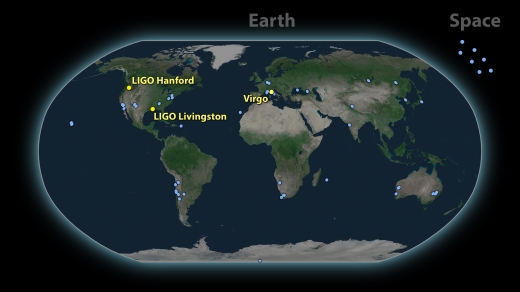
Image: A map of the approximately 70 light-based observatories that detected the gravitational-wave event called GW170817. On August 17, the LIGO and Virgo detectors spotted gravitational waves from two colliding neutron stars. Light-based telescopes around the globe observed the aftermath of the collision in the hours, days, and weeks following. They helped pinpoint the location of the neutron stars and identified signs of heavy elements, such as gold, in the collision’s ejected material. Credit: LIGO-Virgo.
This is the first time I have encountered the term ‘kilonova,’ though the idea behind it is decades old. The properties of this event track theoretical predictions that have been used to explain short gamma-ray bursts, events a thousand times brighter than a typical nova. The simultaneous detection of gravitational waves and gamma rays from this source provides powerful evidence. The merger of two neutron stars, thought to be the cause of the event, has produced a burst of heavy elements moving outbound as fast as .20 c.
Each neutron star in the binary that merged weighed between 1 and 2 solar masses, making the detection of their merger tricky because they are so much smaller than the black holes events we have previously observed. Thus Eliot Quataert (UC-Berkeley):
“We were anticipating LIGO finding a neutron star merger in the coming years but to see it so nearby – for astronomers – and so bright in normal light has exceeded all of our wildest expectations. And, even more amazingly, it turns out that most of our predictions of what neutron star mergers would look like as seen by normal telescopes were right!”
Thus we expand our understanding of how heavy elements are created, a process that can happen in stellar cores through fusion up to iron. Just how elements beyond iron are produced has always been a major issue in astrophysics, but neutron star mergers offer a solution. It was evidently Quataert, working with Brian Metzger (Columbia University) and Daniel Kasen (UC-Berkeley) who applied the term ‘kilonova’ to such events in a 2010 paper (see this UC-Berkeley news release). Kasen refers to neutron star merger debris as ‘weird stuff — a mixture of precious metals and radioactive waste.’
And Columbia postdoc Jennifer Barnes, who had worked with Kasen at Berkeley, helped nail down what a kilonova should look like:
“When we calculated the opacities of the elements formed in a neutron star merger, we found a lot of variation. The lighter elements were optically similar to elements found in supernovae, but the heavier atoms were more than a hundred times more opaque than what we’re used to seeing in astrophysical explosions,” said Barnes. “If heavy elements are present in the debris from the merger, their high opacity should give kilonovae a reddish hue.”

Image: A team of UC Santa Cruz astronomers led by former UC Berkeley graduate student Ryan Foley was the first to detect the light from the neutron star merger 11 hours after the gravitational waves from the collision reached Earth. The left image shows that the glow (red arrow) was not there four months earlier. Credit: UC-SC, Swopes Telescope and Hubble.
The observations fit the calculations, with the color of the merger event shading from an earlier blue to the reddish signature showing the heavier elements of the inner debris cloud.
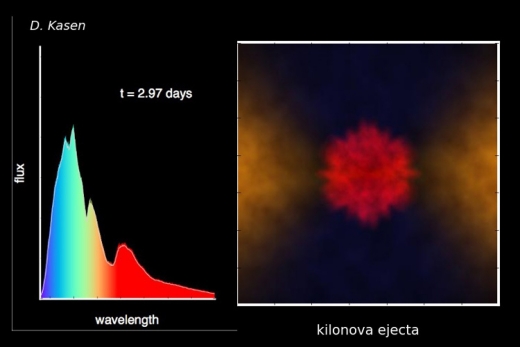
Image: Three days after the merger and explosion, the bright blue glow from lighter elements in the outer polar regions is beginning to fade, giving way to the red glow from the heavier elements in the surrounding doughnut and spherical core. The red glow persisted for more than two weeks. Credit: Dan Kasen.
About 6 percent of a solar mass of heavy elements came out of all this, a yield of gold alone that was more than 200 Earth masses, and a platinum yield of nearly 500 Earth masses. Neutron star mergers, it appears, can account for all the gold in the visible universe. So much for the idea that what we can now call ‘ordinary’ supernovae can account for the heavy elements beyond iron. Clearly, neutron star mergers are a key player. Gravitational wave astronomy is already paying off.
Those wanting to dig into the papers on GW170817 can start with Kasen et al., “Origin of the heavy elements in binary neutron-star mergers from a gravitational-wave event,” Nature 16 October 2017 (abstract), as well as Arcavi et al., “Optical emission from a kilonova following a gravitational-wave-detected neutron-star merger,” Nature 16 October 2017 (abstract) and work from there. The UC-Berkeley news release cited above contains links to a variety of key sources.

Robotic Asteroid Mining: Bootstrapping the Solar System Economy
Centauri Dreams returns with an essay by long-time contributor Alex Tolley. If we need to grow a much bigger economy to make starships possible one day, the best way to proceed should be through building an infrastructure starting in the inner Solar System and working outward. Alex digs into the issues here, starting with earlier conceptions of how it might be done, and the present understanding that artificial intelligence is moving at such a clip that it will affect all of our ventures as we transform into a truly space-faring species. Under the microscope here is a company called SpaceFab, as Alex explains below, and the potential of ISRU — in situ resource utilization. Emerging out of all this is a new model for expansion.
by Alex Tolley

“Asteroid Facility” – Syd Mead
To sail the heavens and reach the stars is extremely expensive. With the technologies we can currently envisage, Earth’s GDP will need to be orders of magnitude larger to support a starship program. Unfortunately, the Earth is likely to hit environmental and economic limits well before we reach the necessary size of a starship building GDP. One solution is for humanity to expand into the solar system to grow the economy with the vast resources available out there [5]. Science fiction novels are replete with tales about self-reliant belters extracting wealth from the asteroids, while followed by adventurers, gold-diggers and chancers, that recapitulate the myths of the “Old West” and the US’ manifest destiny [1].

Space Habitat – John Berkey
By the late 1970s, establishing space colonies and selling solar power to Earth [2] was the idée du jour. Allen Steele popularized that vision, regaling us with stories of men and women living and working on the high frontier [3]. In reality, the cost of transporting and housing space workers is astronomical compared to those of ocean rig workers whose jobs those high-frontiersmen emulated. An economy supporting a wealthy, post-scarcity civilization living throughout the solar system and able to support starship exploration became more fanciful, and we focussed on scaling back our starship ambitions with 1-gram, laser-propelled, sail ships that might launch half a century hence.
 Exploring the Asteroids – Robert McCall
Exploring the Asteroids – Robert McCall
While the prospects for humans in space dimmed somewhat, a renewed flowering of developments in AI and robotics burst onto the scene with capabilities that astonished us each year. On the endlessly orbiting ISS, while astronauts entertained us with tricks that we have seen since the dawn of spaceflight, autonomous robots improved by leaps and bounds. Within a decade of a DARPA road challenge, driverless cars that could best most human drivers for safety appeared on the roads. Dextrous robots replaced humans in factories in a wide variety of industries and threaten to dramatically displace human workers. DeepMind’s AlphaGo AI beat the world’s champion GO player with moves described as “beautiful” and well within the predicted time frames. In space, robotic craft have visited every planet in the solar system and smart rovers are crawling over the face of Mars. A private robot may soon be on the Moon. In orbit, swarms of small satellites, packing more compute power than a 1990 vintage Cray supercomputer, are monitoring the Earth with imaging technologies that equal those of some large government satellites. On Earth we have seen the birth of additive manufacturing, AKA 3D printing, promising to put individual crafting of objects in the hands of everyone.
What this portends is an intelligent, machine-based economy in space. Machines able to operate where humans cannot easily go, are ideally suited to operating there. Increasingly lightweight and capable, and heedless of life support systems, robotic missions are much cheaper.. How long before the balance tips overwhelmingly in the machines’ favor? Operating autonomously, advanced machines might rapidly transform the solar system.
In a previous post, “A Vision to Bootstrap the Solar System Economy” [4], I looked at an academic paper that laid out an idea of self replicating robots that would start harvesting lunar resources and eventually expand operations out to the asteroid belt. The power of exponential growth to bootstrap such a system was clearly evident, allowing a relatively tiny investment to create a huge manufacturing capability of staggering size within a short time with growth rates far exceeding our current human-based economies. An interesting idea and vision, but was anyone going to consider developing a business using that approach? A new company, SpaceFab, shares a similar vision. The founders want to create a fleet of mining and fabrication robots that will extract raw materials from the asteroids to create refined commodities and products in space, including building more robot miners and fabricators. A grand vision, but how do they envisage it being done?
While the original idea of asteroid mining was to extract the non-volatile resources, especially the high value platinum group metals [5], more recently the focus has shifted to volatiles, primarily water, for life support and chemical rocket fuels. SpaceFab however, prefers the extraction of the more abundant iron and nickel, whose current value in space is principally their launch cost. Their argument for this focus is twofold. Firstly, water is relatively rare in most near Earth asteroids (NEA) and therefore likely to be more difficult to extract from those bodies. While common in asteroids beyond the frost-line or in dead comets [10], the delta v cost is high and journey times much longer. Conversely, metals are far more accessible inside the frost-line with NEAs, reducing both the cost to acquire these metals and the mission cycle time. Secondly, SpaceFab is looking to extract iron and nickel using simple, lightweight and low-cost processes like magnetic collection of material, and induction heating to melt and refine the metals. Their view is that the path to profitability is faster with this approach than prospecting and extracting volatiles.

The OSIRIS-REx mission is NASA New Frontiers mission to return a sample of an asteroid (101955 Bennu) to the Earth. Mission cost is approximately $800 million (excluding the launch vehicle.). – Lockheed Martin
SpaceFab believes that they might get a sample return mission to an M-type asteroid within 10 years and a mining craft 5 years later. Their design target is for a craft just 1 MT in mass (about the same size as OSIRIS-REx), and consists of an ion engine, rock scraping tools for extracting material, and some form of electrical induction heating to produce refined ingots. When sufficient extraction is achieved those refined ingots could then be used as feedstock for space manufacturing. While apparently ambitious, the concept of small craft to mine asteroids has been developed by Calla, Fries and Welch and was presented in two papers at the IAC in 2017. Their craft were designed to be less than 500Kg. Water in close by NEAs was their objective based on their analysis of extraction methods which indicated using microwave thermal heating. Teleoperation from Earth was assumed and therefore an NEA within 0.03 AU was preferred. The small size combined with a swarm model for redundancy was the most economically modeled approach to provide a large and early return on investment [15,16].For robotic craft on deep space missions, high Isp electric engines reduce costs, as the lower propellant mass means lower launch costs. To keep costs low, SpaceFab intends to use off-the-shelf ion engines that may be augmented by their ion accelerator technology (patent pending) that they claim boosts Isp several fold. With the Dawn mission spacecraft’s NSTAR ion engine having an Isp of 3100s, Spacefab might hope for an augmented Isp of up to 10,000s. The addition of this accelerator unit and the solar panels to power it should increase the mass ratio performance of the craft.
So far SpaceFab’s approach seems similar to other schemes to mine asteroids. Where SpaceFab’s vision really differs is the use of ISRU (in situ resource utilization) for construction of onsite mining and fabrication tools. Rather than hauling out machine tools to an asteroid to extract and fabricate components, SpaceFab plans to reduce the mining craft’s mass, and therefore cost, by building many of the machine tools for mining and fabrication using local resources. It is just one step further to replicate the whole craft. This model of self replication of much of the mass of the machines is similar in concept to the robot bootstrapping paper and promises to open up exponential mining and fabrication possibilities, while making the owners quite wealthy.
Most asteroids are too far away to allow teleoperation of the sort that would work on the Moon or with close NEAs. This rules out complex manufacturing guided by human controllers. The intelligence needed to prospect, mine and process ores must be local. Beyond some human oversight, these robot mining craft and fabricators will need to be highly autonomous. This requires advanced AIs. While we are not close to that goal today, the rapid pace of development of AI software and specialized chip hardware promises to make this a reality sometime in the projected time frame. Such craft will be able to navigate to a selected asteroid, prospect it, extract and refine metals, and then fabricate machine tools and manufacture components. SpaceFab believes that such craft could even provide a “manufacturing on demand” service in space. On Earth we have seen the birth of additive manufacturing, AKA 3D printing, promising to put individual crafting of objects in the hands of everyone. The technology is already being tested on the ISS to reduce the number of spare parts that must be shipped.
Fabrication, even self-replication, is no longer a science fiction concept. Nasa has a “FabLab” program to investigate the best ways of using that technology to facilitate spaceflight as a result of its success with 3D printing experiments on the ISS. Neil Gershenfeld’s lab at MIT has designed a method of robotic self-replication suitable for use in space. The current proposed system can fit inside a CubeSat [14]. The basic technologies needed for SpaceFab’s vision are already in place, just requiring further development.
The eventual goal of robot miners and fabricators producing commodities and goods at a fraction of today’s prices, via massive supply expansion, may face some short term obstacles. Low launch costs spearheaded by NewSpace companies like SpaceX could make placing raw materials in space cheaper than space mining, for cis-Lunar infrastructure. However, space fabrication of components in situ is a useful goal, regardless of the raw material source. In the 1980s, K. Eric Drexler intended to manufacture ultra-light, aluminum solar sails in space. T. A. Heppenheimer described manufacturing trusses for solar powersat arrays using relatively dumb, machines bending and welding rolled sheets of aluminum. Grumman Aerospace had a working prototype “Composite Beam Builder” by the time Heppenheimer’s book [5] was published. More recently, NIAC has funded space fabrication projects using more sophisticated robotic builders.
At some point, regardless of cost, the sheer volume of resources for expanding the economy will require sourcing from space to overcome the Earth’s limitations. Robotic mining and fabrication will then become the norm. As with newly industrializing Earth-based economies, initial fabrication may be for simple, low value added, bulk commodity products, but eventually as capabilities increase, higher value added manufactures will be possible.
Although initially limited by key components like advanced computer chips, over the long term, self-replicating craft would evolve into Von Neumann replicators. Philip Dick invented the term autofac for factories that could construct themselves from seeds and self replicate [6]. While Von Neumann machines are just self replicators, autofacs also generate outputs, much as honeybee colonies also produce excess honey. Such self-replication and fabrication infrastructure could produce a vast range of products for the solar system economy.

SpaceFab’s Waypoint Telescope – engineering mockup.
To reach the goal of space mining and manufacturing without the deep pockets of a Deep Space Industries or Planetary Resources, SpaceFab intends to enter the orbital satellite observation market. They have designed a low cost, high resolution (1 meter ground resolution) telescope that can be used both for astronomical and Earth observation purposes, using a variety of imaging sensors and filters that offer the range of imaging outputs suitable for both markets. Currently they are crowd-funding their initial prototype telescope which will be followed by a flight ready telescope for a 2019 launch. By launching a fleet of such telescopes, they expect to penetrate this market by offering the lowest price imaging and analysis services.
This observation service would then produce the profits needed to develop the asteroid mining craft and bootstrap the space fabrication business. Interestingly, SpaceFab currently has no intention of using these observation satellites to prospect for suitable asteroids as DSI intends, but rather to use existing information to enable a mission to an M-type NEA. As this information will not be detailed enough for detecting higher quality ores, the spacecraft will need to be smart enough to do their own prospecting on arrival at an asteroid. SpaceFab speculates that in the near term, the value of fairly pristine asteroidal material may be higher for research than its commodity price and may offer a faster path to early profitability.
Once mature, self-replicating fabs promise a future that has vastly expanded horizons and implies a post-scarcity economy. Once such seed factories become ubiquitous, there is no reason why they could not venture to other solar systems and replicate there. Even if slow, perhaps travelling at 1/100th c, they would reach the nearer stars in half a millennium, creating all the materials and habitats for humans to occupy. This is the model that Asimov’s “spacers” envisaged for themselves [7], their robots preparing the way for them to follow. The colonization process would be with a wave of machines preparing star systems for the following human starships.
It is a dazzling future to contemplate if it unfolds this way.
References
- Anderson, Poul. Tales of the Flying Mountains. Tom Doherty Associates, 1970.
- O’Neill, Gerard K. The High Frontier: Human Colonies in Space. Morrow, 1977.
- Steele, Allen M. Sex and Violence in Zero-G: the Complete Near-Space Stories. Meisha Merlin Pub., 1998.
- Tolley, Alex “A Vision to Bootstrap the Solar System Economy” https://www.centauri-dreams.org/?p=36963
- Lewis, John S. Mining the Sky: Untold Riches from the Asteroids, Comets, and Planets. Addison-Wesley, 1998.
- Heppenheimer, T. A. Toward Distant Suns. Stackpole, 1979.
- Dick, Philip K. “Autofac.” The Collected Stories of Philip K. Dick, Subterranean Press, 2010.
- Asimov, Isaac. The Robots of Dawn. Bantam Books, 1994.
- SpaceFab http://www.SpaceFab.us/
- Graps, A et al. “In-Space Utilization of Asteroids – Answers to Questions from the Asteroid Miners”, ASIME 2016: Asteroid Intersections with Mine Engineering, Luxembourg. September 21-22, 2016. arxiv.org/abs/1612.00709
- Brophy, J., et al. “Asteroid Retrieval Feasibility Study” (2012). Keck Institute for Space Studies, Caltech, JPL. kiss.caltech.edu/final_reports/Asteroid_final_report.pdf
- Welch, C., et al. Asteroid Mining Technologies Roadmap and Applications (ASTRA)” (2010) , International Space University isulibrary.isunet.edu/opac/doc_num.php?explnum_id=73
- Mazanek, D. “Asteroid Redirect Mission Concept: A Bold Approach for Utilizing Space Resources.” Acta Astronautica, Pergamon, 23 July 2015, www.sciencedirect.com/science/article/pii/S0094576515002635.
- Langford, Will, et al. “Hierarchical Assembly of a Self-Replicating Spacecraft.” 2017 IEEE Aerospace Conference, 2017, doi:10.1109/aero.2017.7943956.
- Calla, P., Fries, D., Welch, C. “Analysis of an Asteroid Mining Architecture utilizing Small Spacecraft”, IAC 2017
- Calla, P., Fries, D., Welch, C. “Low-Cost Asteroid Mining Using Small Spacecraft”, IAC 2017

